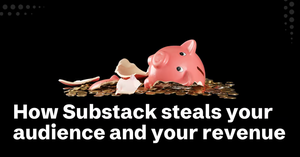Brought to you by the fine folks at Outpost for Ghost publishers. Get more subscription revenue for your Ghost publication with Outpost 🪐

Correction: I have clarified below in context that “app” means both web and mobile. Substack is an app that works across platforms.
The Substack guys are bad news.
Journalists have been publicly abandoning the platform since the transphobic writers controversy of 2021. Then, it came to light that Substack’s founders are nazi sympathizers who to this day refuse to properly respond to nazis. No surprise since they are known techno fascists who hang out with Peter Thiel, Marc Andreessen, Palmer Luckey and…Kevin Spacey.
When they announced they would bankroll an enterprise version of Bari Weiss’s The Free Press of Worst Possible Takes, a publication sponsored by Uber and Airbnb with whom Substack shares at least one investor, it was all too predictable.
So, why are writers who know this still publishing on Substack?
It’s because they think Substack will help them grow a monetizable audience.
Sure, the Substack dudes are truly terrible people, but at least I can make a good buck there, right?
This is their greatest con. The vast majority of former Substack publishers I speak with make more money when they leave the platform. And the audience growth there is juiced by a rampant bot problem.
Today, I’m unpacking how exactly Substack is stealing your audience and your revenue. Substack is not just bad for society, they are also bad for your business.
How Substack steals your audience
YOUR readers become THEIR app users
When you send your fans over to subscribe to your publication, they are not just joining your list, they are now joining the Substack userbase. Substack pushes your audience over to their app every chance they get. Inside your welcome email. Inside every email you send. Every time your reader opens your post on a mobile device.
Growing their own active userbase is high priority and they will always pretend that it somehow benefits you. I particularly love how cofounder Hamish McKenzie said that “subscribers who use the app are much more likely to share, like, comment on, or restack your work than before they installed the app” when you literally cannot do those activities outside of their app. Make it make sense.
(Correction/clarification: “app” here means web and mobile app. Their underlying app shares the same database even though you visit it on your computer, tablet or phone. It’s all one big app with different clients, web and mobile. It is not your own database or website.)
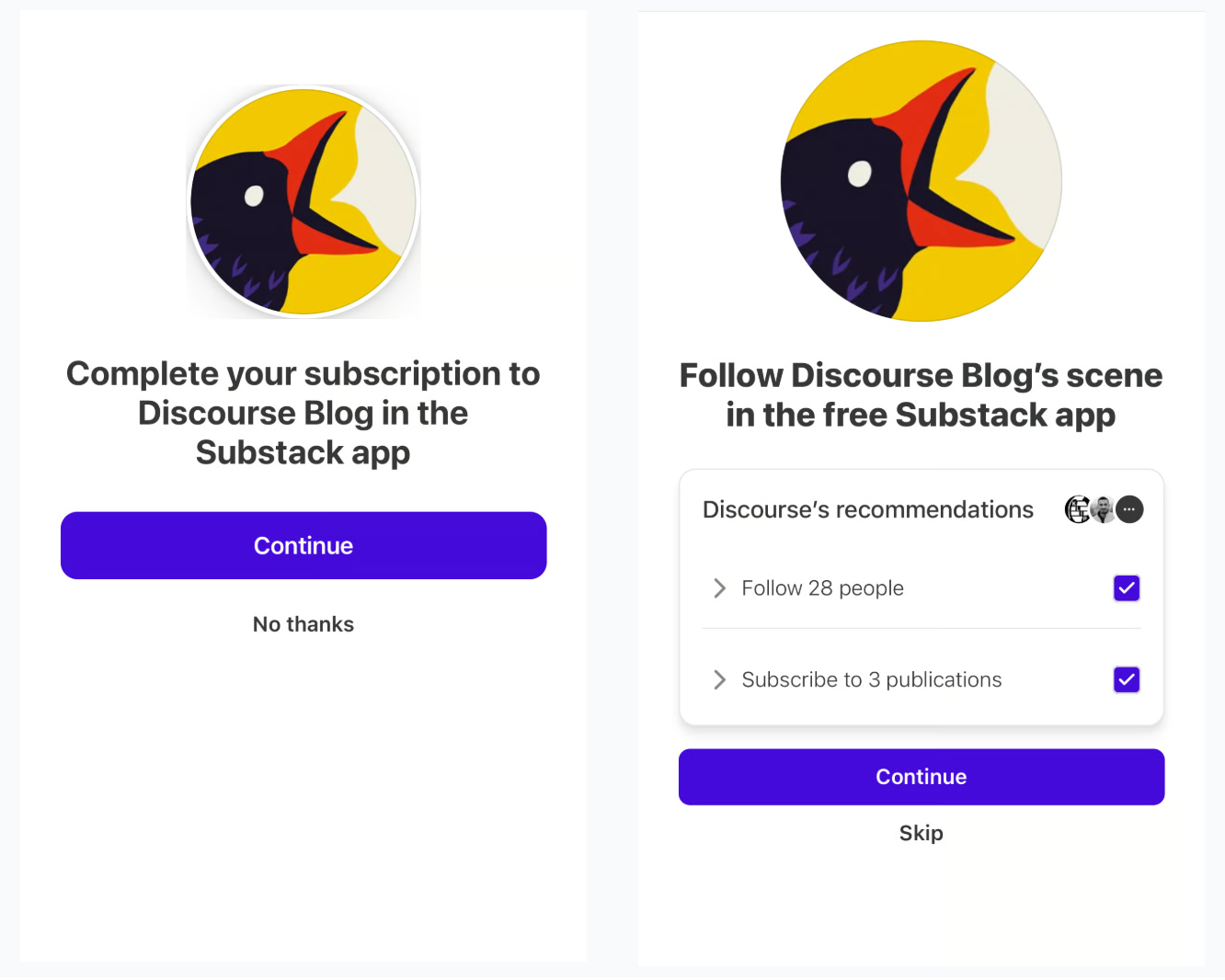
They get your audience to opt out of your emails
Once they’ve got YOUR fan in THEIR app, Substack encourages them to enable something called “smart notifications” which essentially removes this person from your email list.
Instead, your reader will get push notifications in the Substack app when you publish. Should you decide to leave Substack, you’ll have a bunch of readers who have opted out of your email list who you will either need to re-establish email permission with or who you’ll lose altogether.
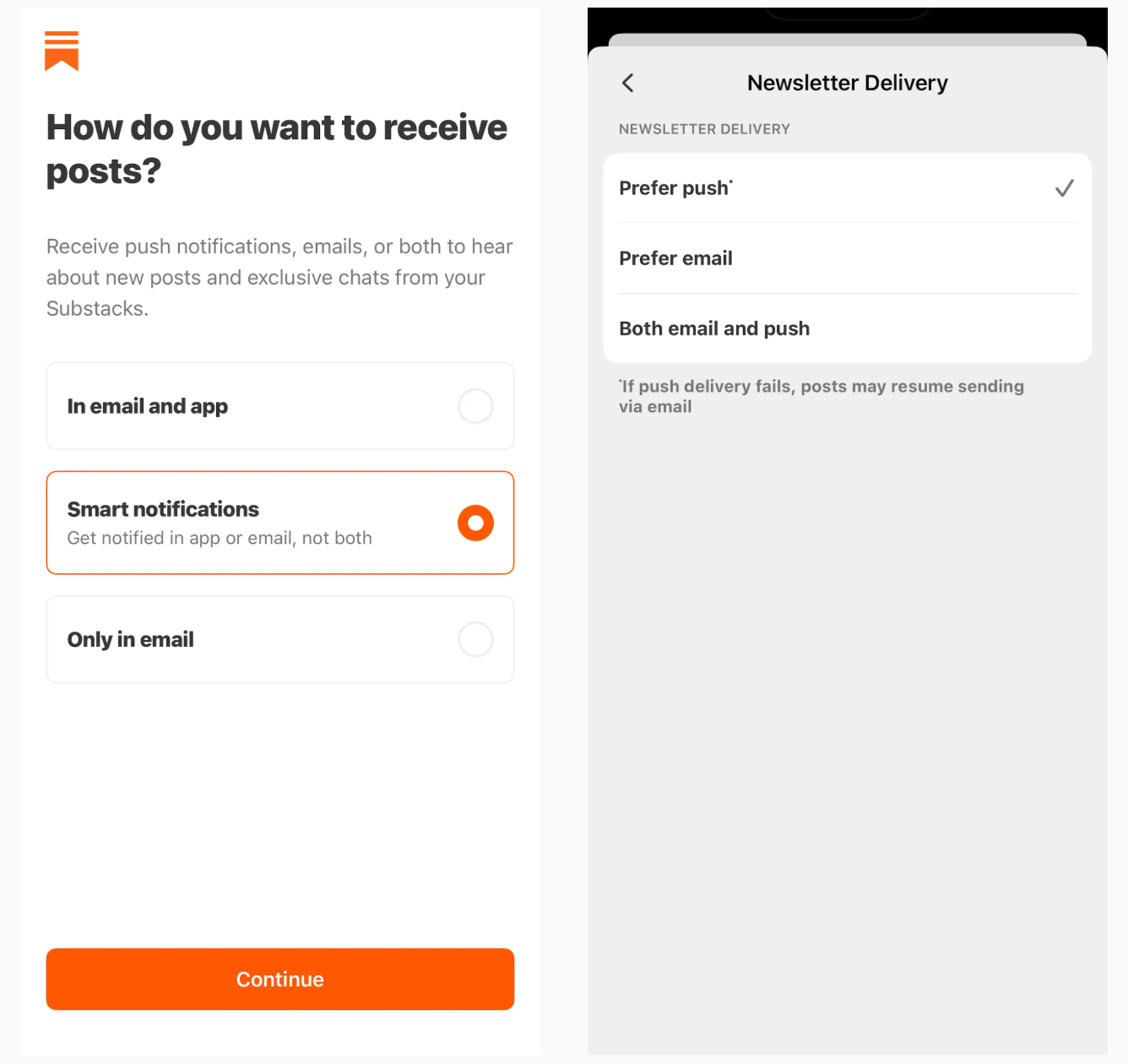
They exhaust your audience with content and notifications
Substack is famous for their recommendation feature. As a growth marketer, I like this feature, but Substack has ruined anything that was good about it. With the click of a button, you’ve just opted in to hear from a bunch of new creators, and you can’t easily see who they are!
Your fan—who once just wanted to subscribe to follow your work—is now inundated with information from all sides within seconds. You’re now just a tiny part of their feed like you were on any other social media platform. So much for having “a direct relationship with your audience.”
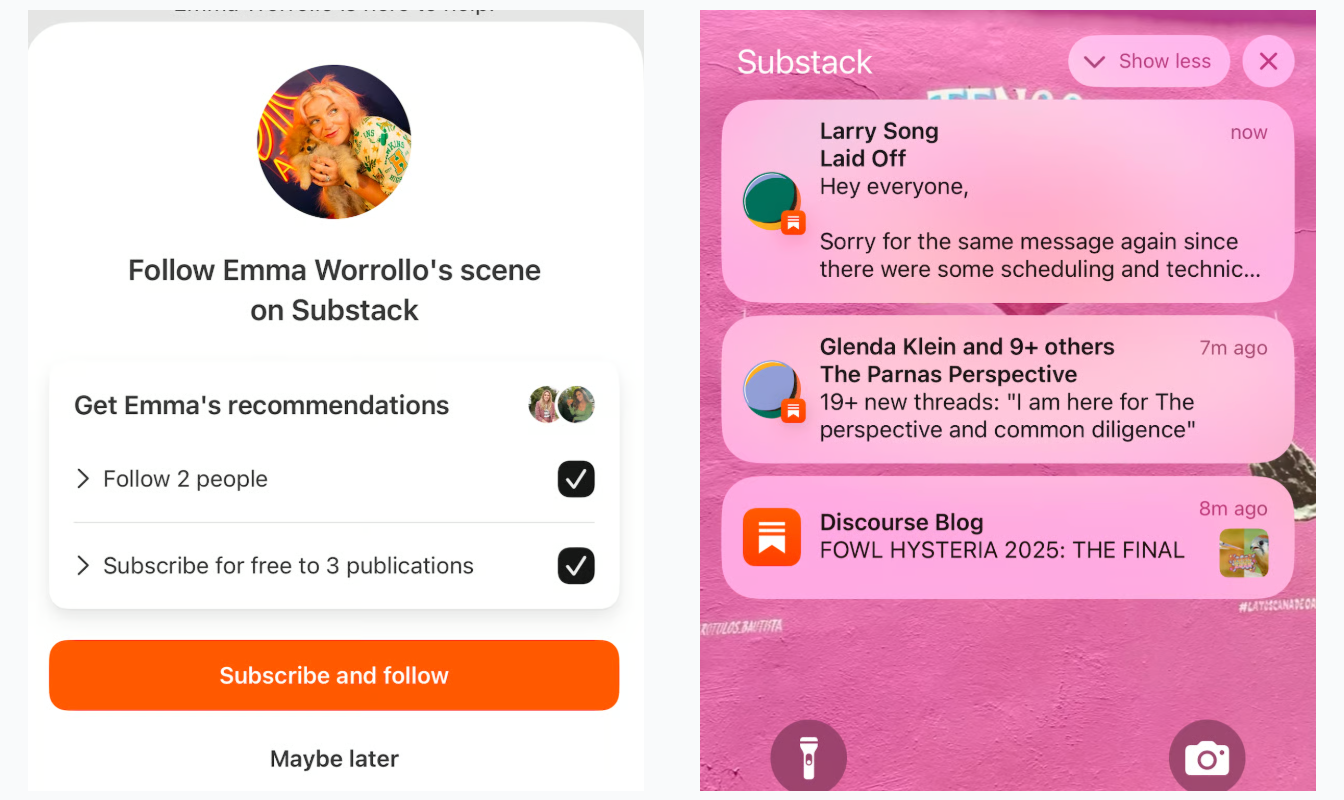
You’re building more of a following than a subscriber base
Substack introduced followers in 2023. When you create on their platform, you are not necessarily building your email list or your “owned” audience (I hate this term). You are building your following on Substack, which you cannot take with you anywhere else.
The Follow feature pairs with the Notes feature. Both Substack and self-proclaimed Substack growth experts will insist Notes helps you grow your subscriber base. But Notes will mainly attract followers and likes—both of which have less revenue potential than the same activity on other social platforms where either the platform pays you or where you can take on brand sponsorships. Who benefits most here? Substack’s daily active user count.
How Substack steals your revenue
13% of your revenue goes to fees
Substack takes a 10% platform fee plus you pay 3% to Stripe, their payment processor. That’s 13% of your revenue lost on every single new subscriber. A $7 subscriber is actually $6. A $5 one closer to $4.
Substack has some of the highest fees across all publishing and creator platforms. Patreon is the only one I could find that is higher (you can pay upwards of 15-17% there, including payment processing). Ghost, Buttondown and beehiiv take no fee on top of Stripe, so you pay 3% through each of them (along with a subscription fee you pay to host there). Kit takes less than 1% (4% total with Stripe) and Buy Me a Coffee and Ko-fi both take 5% (which is 8% with Stripe’s fee).
Molly White of Citation Needed, who moved from Substack to Ghost, did the math and found that once you have 18 paid subscribers (at $5/mo), it’s cheaper to move off Substack and pay for a subscription to Ghost or Buttondown. Film critic Ty Burr also told me he made more money after he left Substack for Ghost.
They still take 10% after you leave
If you choose to leave Substack, they will keep taking their 10% on all your subscriptions. You have to contact them manually to remove this cut.
No paid upgrades in their app
Substack promotes the hell out of their app so surely you can upgrade to paid inside it, because they love helping creators make money, right? Not so! As Alex Dobrenko pointed out, you cannot upgrade or manage a paid subscription from Substack’s mobile app.
This is probably because both Apple and Google take hefty platform fees from subscriptions—15-30% on top of Substack’s cut—so publishers would be only taking home 60% of their revenue and Substack would make much less too. But if Substack is going prioritize their own app and get your readers opting out of emails, shouldn’t they at least give you this option?
Patreon built in some functionality to give creators control over this in their mobile apps, including passing this fee onto your subscriber (minor for them, major for you). Substack once again makes a revenue decision on your behalf and their decision is for you to make less money.
They limit you to 1 subscription tier
You can only have 1 subscription tier in Substack. You can add monthly and annual pricing, a founding member tier and a group subscription (multiple seats). But you cannot have a tier for your paywall and a tier for your Discord, for example.
It’s common for publishers going into their 2nd or 3rd year to encourage subscribers to bump up to a higher tier but that’s not possible in Substack. You’re stuck with what they gave you: 1 pricing tier.
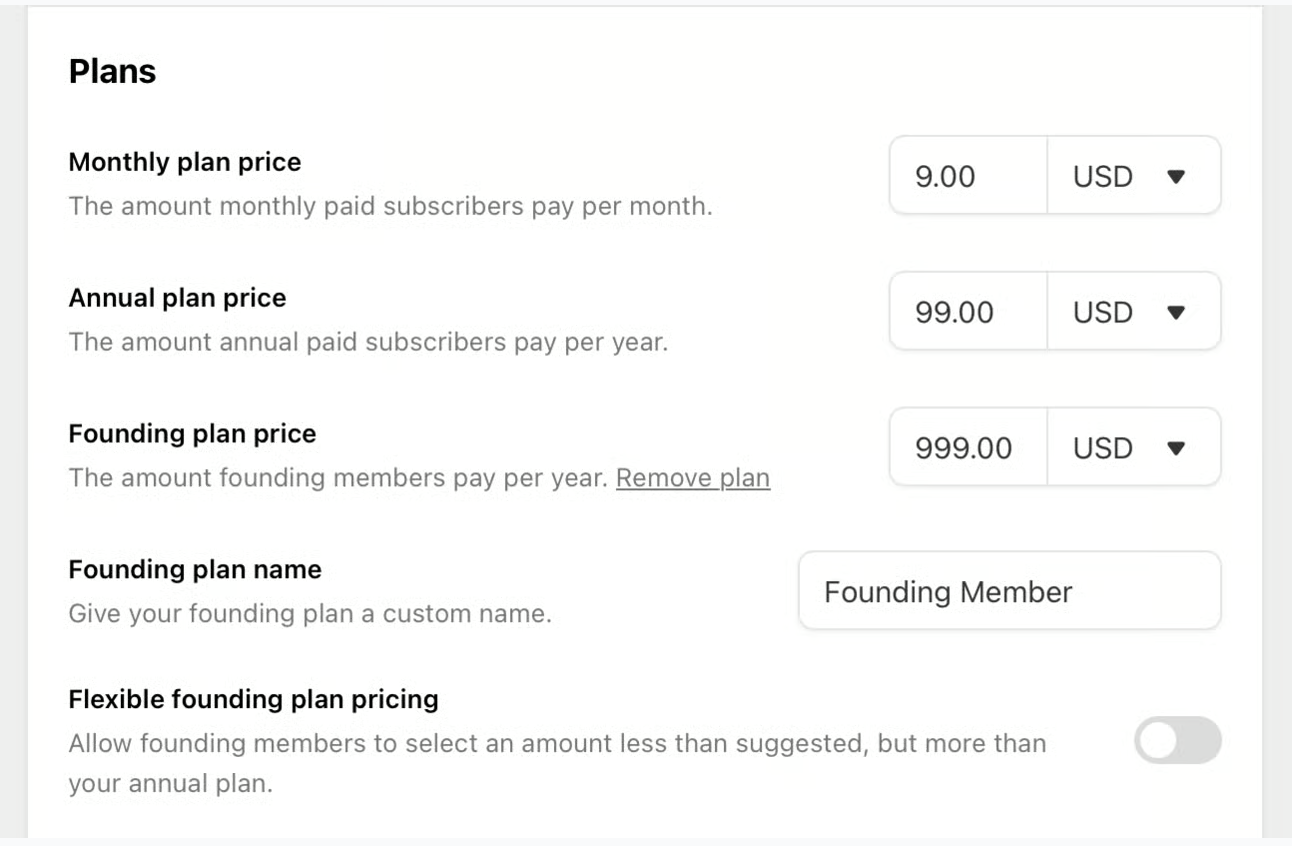
No other revenue streams
Substack offers no other way to make money aside from subscriptions. There’s no tip jar, no sponsorship marketplace, no event tickets, no merch integration. Nothing.
A huge miss when even some of their biggest publishers stall out on subscriptions and need to diversify income. Eric Newcomer said his paid subscriptions were mostly flat for two years (with over 100k readers) and his main revenue growth was coming from events and sponsors, no thanks to Substack.
No platform revenue stream
Substack doesn’t pay creators, so for video makers coming from YouTube and TikTok, you’re also missing out on platform revenue from the YouTube Partner program or the TikTok creator rewards program.
That’s why Substack had to put up a $20M revenue guarantee for video creators coming over this year. Those creators seem happy on Substack for reasons I can’t figure out because they just killed two revenue streams (platform and brand deals), but if you are a smaller video creator, you will limit your path to revenue on Substack.
A free trial that doesn’t work
You may have noticed when you read someone’s post on Substack, it will offer you a 7 day free trial on a paid subscription. It is absolutely your prerogative as a publisher to try this for yourself and see if it works for you. But Substack has enforced this as a widespread standard practice within their ecosystem so it is now expected by their userbase and many Substack publishers complain that it does not lead to people actually becoming paid subscribers.
Discounting your work and pretending it’s a growth hack
Substack doesn’t seem to know how to get you more paid subscribers so they introduced this feature called Boost where they discount your subscriptions.
After someone upgrades to another publication, they’ll show a menu of Substacks with discounts on all of them, including yours. Hilariously they call this “growth on autopilot” when, in fact, it is just discounts on autopilot. Who eats this cost? It’s you!
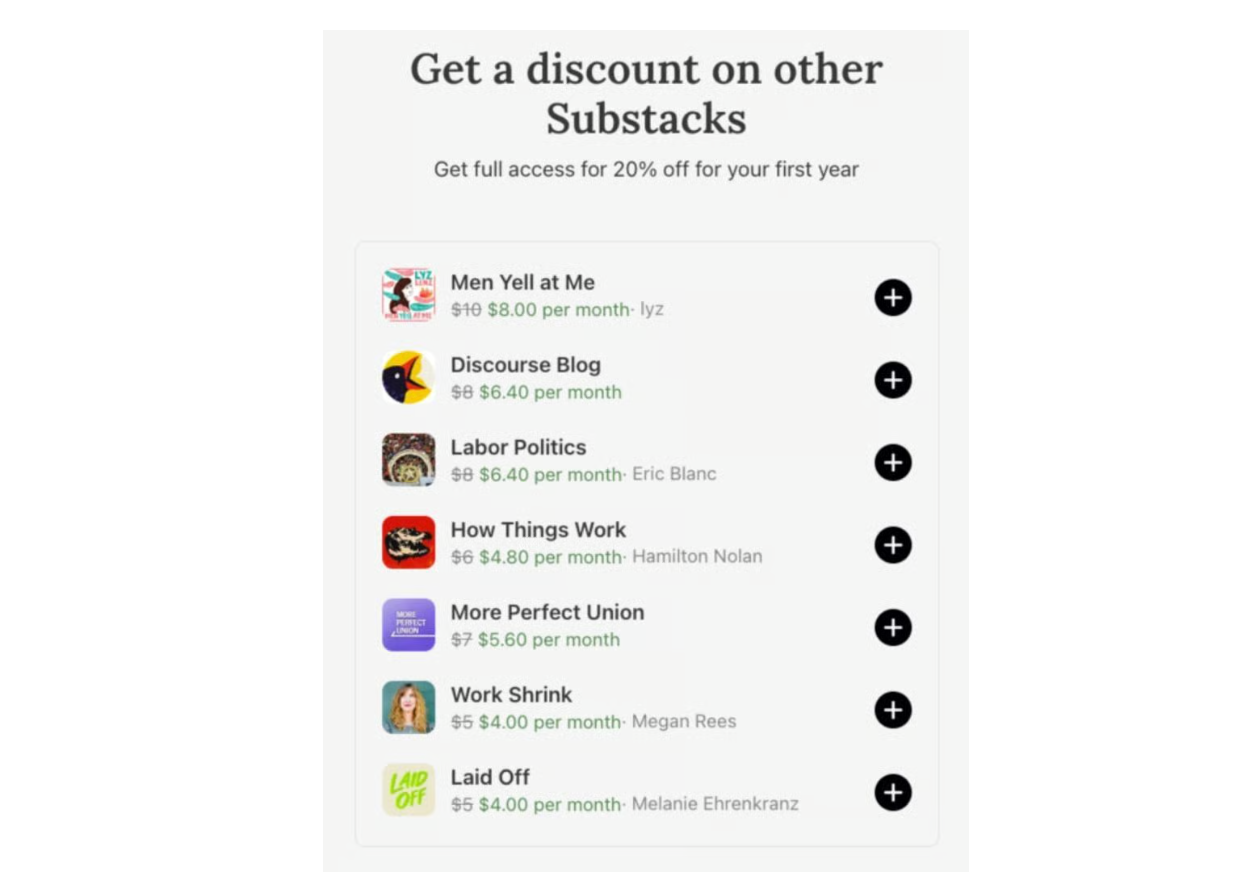
Prohibiting sales content
So, by now, you know Substack’s falling down on their promise to get you paid subscribers and you want to promote your own paid subscription. Wait just a minute…you can’t! Substack’s own content guidelines state “Substack is intended for high quality editorial content, not conventional email marketing.”
Any of us who have run a paid subscription know that you need both editorial and email marketing. Substack won’t sell for you and they don’t want you to sell for yourself either.
Substack’s got even more fatal flaws
On top of stealing your audience and your revenue, Substack’s increasingly just an unstable, unusable place for your work…and your credit card information.
Your subscribers might end up paying for someone else’s subscriptions
Turns out if you forward an email to a friend and they upgrade to a paid subscription, it will actually upgrade YOU to a paid subscription. This is a huge security bug that Substack is aware of, having to do with how they authenticate users via one click. Substack users have reported it several times but it remains broken.
I got a DM on Substack from Lisa who forwarded a Substack newsletter to her friend. Her friend upgraded to paid. But, Lisa got the upgrade alert. She noticed her Substack account was tied to her friend’s credit card and future upgrades would all be charged to her friend. At least 3 people reported this happened to them in a Reddit thread. It’s happened to Lisa twice. Absolutely bananas that this isn’t fixed yet.
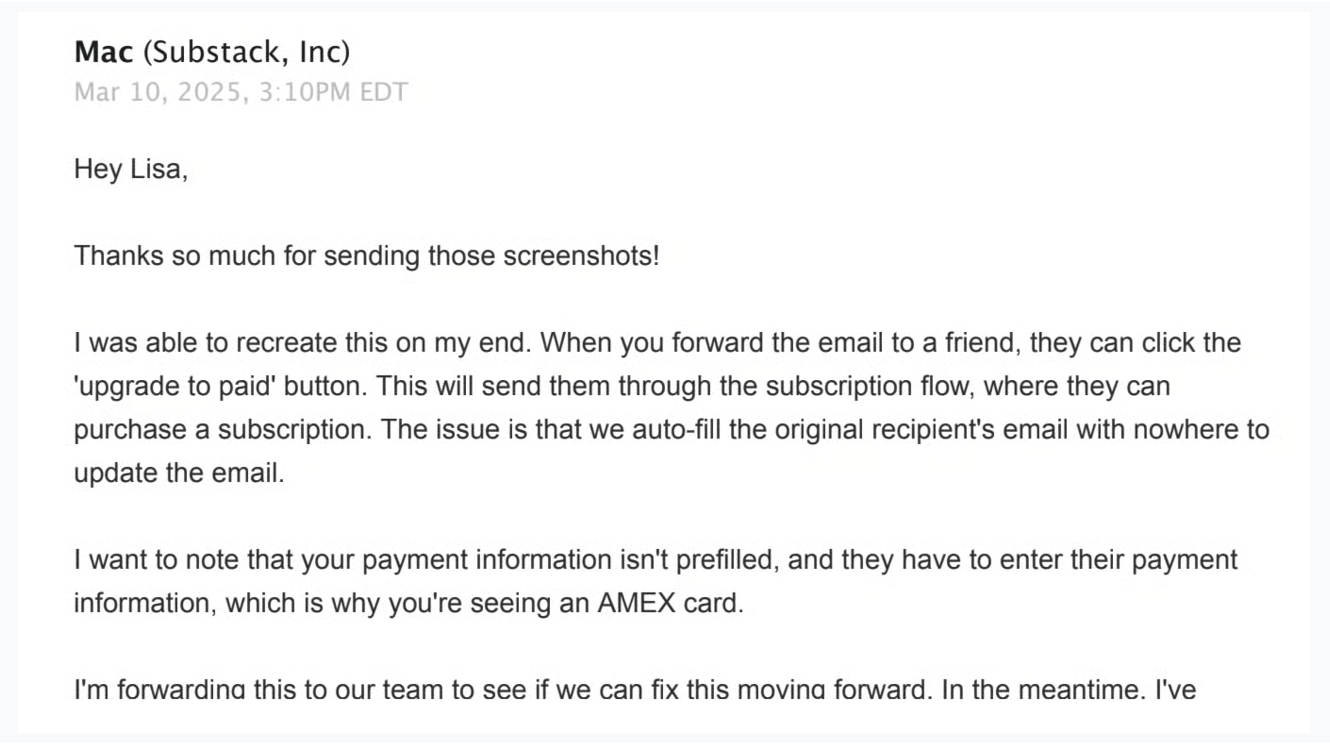
Substack might randomly publish your drafts
Multiple Substack writers reported this week that bots “restacked” (a.k.a. promoted in the feed) their unpublished drafts.
Based on the accounts I read on Reddit (here and here) it doesn’t actually seem like the drafts were, in fact, published publicly but whatever is going on with Substack’s tech infrastructure that allowed porn bots to access private drafts at all should be a red alert for their engineering team. Substack’s been radio silent about it.
Substack lies about your revenue growth…and maybe their own?
Substack shows an “estimated revenue increase” on every post you publish. Except they will only show you new paying subscribers, not churned subscribers. Gain 3, lose 5, Substack pretends you made money!
This makes me wonder about their 5 million paid subscriptions metric, which jumped up from 4 million quickly, thanks to acquiring a bunch of big TikTokers and major media names.
Are they actually at 5 million ACTIVE subscriptions or is it ALL TIME subscriptions? They’re famously cagey about metrics so who the hell knows. Someone would have to clarify how they define this or maybe even try to get a visual of their data.
Substack’s full of problems but their worst offense is that they’ve conned so many journalists and writers into thinking they CAN’T SURVIVE WITHOUT SUBSTACK.
Substack’s cofounders constantly pump out cultlike affirmations like “a profound redistribution of power is underway” while using imagery of “gardens” and “magic dust” to woo writers into a trancelike state where they buy into the hype. Surely, there’s no alternative to this happy land of thought geniuses?
This is the worst part. It’s bad for everyone to be on one platform. It’s bad for that platform to suck so much. It’s bad for writers to believe they have to rely on a tech company to find their audience. All this is doing is re-concentrating any power those individual writers could have had with Substack as the central authority and beneficiary of their labor.
I used to think there were reasons to start on Substack, but with them stealing so much of your audience and revenue now, I would steer clear and go ANYWHERE else.
Substack is like gambling at a casino. A few will hit it big, but most will walk away with less than they came in with. The house always wins.

